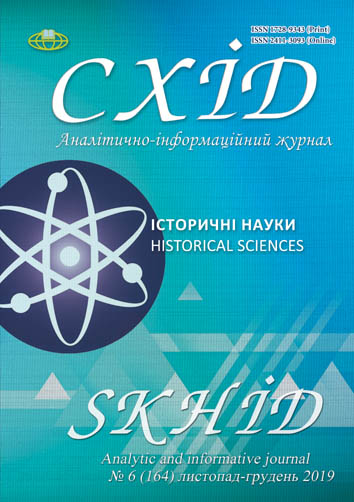USA propaganda in Cold War period: formation of the image of enemy in face of the USSR
DOI:
https://doi.org/10.21847/1728-9343.2019.6(164).186900Keywords:
the Cold War, image of the enemy, propaganda, read menace, nuclear threat, the Iron CurtainAbstract
The analysis of asymmetric threats in past armed confrontations makes it possible to evaluate the risks in similar situations today. The Cold War of 1946-1991 is not an exception, because the experience of using propaganda influence by both parties in it is an inexhaustible source for generalization and predictions of the processes around the Russian-Ukrainian conflict, which are gradually described by modern military and political experts as the “Cold War of the XXI century”. Publications existing in the post-Soviet space largely suffer from the orthodoxy of their views. This limits the ability to evaluate objectively the forms and methods of forming public opinion in the United States regarding a political enemy after the Second World War, and thus impoverishes knowledge of possible options for the unfolding of events for our country in the opposition of such type, and, accordingly, the ability to predict the situation. The proposed study attempts to differentiate itself from Soviet and post-Soviet sources of information and, based solely on US publications, to identify the main cliches formed in the US information space regarding the image of the enemy in the face of the USSR.Downloads
References
Barsamian, D. (1992). Stenographers to Power: Media and Propaganda. Monroe, ME: Common Courage Press.
Barson, M. and Heller, S. (2001). Red Scared! The Commie Menace in Propaganda and Popular Culture. San Francisco: Chronicle Books.
Chang, W. H. (1991). Images of the Soviet Union in American newspapers: A content analysis of three newspapers. In: Everette, E. Dennis, George, Gerbner and Yassen, N. Zassoursky, (eds.), Bevond the Cold War: Soviet and American Media Images. Newbury Park, CA: Sage, pp. 65-83.
Drake, F. (February 1958). A Realistic Plan for National Survival. Reader’s Digest, рр. 43-47.
Dulles, A. (December, 1954). Progress of Freedom Abroad. Vital Speeches 21: pp. 869-870.
Entman, R. M. (1989). Democracy Without Citizens: Media and the Decay of American Politics. New York: Oxford University Press.
Fish, Н. (July 1931). The Menace of Communism. Philadelphia: American Academy of Political and Social Science, pp. 54-61.
Gallup, G. (June 1952), Why We are Doing So Badly in the Ideological War. Vital Speeches 18, pp. 501 -504.
Gamson, W. A. (1992). Talking Politics. Cambridge, UK: Cambridge University Press.
Garthoff, R. L. (1985). Detente and Confrontation: American-Soviet Relations from Nixon to Reagan. Washington, DC: The Brookings Institution.
Holstein, L. (2002). Framing the Enemy: Changing u.s. Media Images of China and the U.S.S.R. At the End of the Cold War. ProQuest Information and Learning, Ann Arbor, USA.
Hoover, J. E. (9 June 1947). How to Fight Communism: Ten Don’ts by Mr. Hoover." Newsweek, pp. 30-32.
Jo, М. and Buhle, P. and Georgakas, D. (1997). Encyclopedia of the American Left. New York: Garland Publishing Inc., р. 334-336.
Marx, K. and Engels, F. (1848). Manifesto of the Communist Party by February, p. 446. Retrieved from: https://www.marxists.org/archive/marx/works/download/pdf/Manifesto.pdf (Accessed 15 March 2019).
Morris, Richard B. (1982). Encyclopedia of American History. 6th ed. New York: Harper & Row Publishers, рр. 424, 453.
Orwell, G. (1949). 1984. p. 231, Retrieved from: http://www.george-orwell.org/1984/1.html (Accessed 25 May 2019).
Parry-Giles, S. J. (1994). Propaganda, effect, and the Cold War: Gauging the status of America’s “war of words.” Political Communication. 11: 4, pp. 203-213.
Reagan, R. (1989). Speaking My Mind: Selected Speeches. p. 289.
Relations, 1953-1984. Urbana: University of Illinois Press.
Sproule, J. M. (1987). Propaganda studies in American social science: The rise and fall o f the critical paradigm. Quarterly Journal of Speech. 73, pp. 60-78.
Stevenson, R. W. (1985). The Rise and Fall of Detente: Relaxation of Tension in U.S.-Soviet. The Macmillan Press Ltd.
Taft, R. (June 1952). Failure of Administration’s Foreign Policy. Vital Speeches. 18, pp. 517-520.
Weart, S. R. (1988). Nuclear Fear: A History of Images. Harvard University Press, 535 p.
Weisberg, J. (November 28, 1999). Cold War Without End. Retrieved from: https://www.nytimes.com/1999/11/28/magazine/cold-war-without-end.html (Accessed 21 May 2019).
Weldes, J. (1999). Constructing National Interests: The United States and the Cuban Missile Crisis. Minneapolis: University of Minnesota Press.
Whitney, J. (1954). Women-Russia's Second-Class Citizens. Retrieved from: http://www.writing.upenn.edu/~afilreis/50s/home.html (Accessed 23 May 2019).
Willis, D. K. (1985). Klass How the Russians Really Lived. New York: St. Martens Press.
Downloads
Published
How to Cite
Issue
Section
License
Copyright (c) 2019 Vadym Bespeka

This work is licensed under a Creative Commons Attribution-NonCommercial-NoDerivatives 4.0 International License.
1. Authors bear responsibility for the accuracy of facts, quotations, numbers and names used.
2. Manuscripts are not sent back.
3. The publisher does not always agree with the authors' opinion.
4. The authors reserve the right to authorship of the work and pass the first publication right of this work to the journal under the terms of a Attribution-NonCommercial-NoDerivatives 4.0 International, which allows others to freely distribute the published research with the obligatory reference to the authors of the original work and the first publication of the work in this journal.
5. The authors have the right to conclude separate supplement agreements that relate to non-exclusive work distribution in the form in which it has been published by the journal (for example, to upload the work to the online storage of the journal or publish it as part of a monograph), provided that the reference to the first publication of the work in this journal is included.

